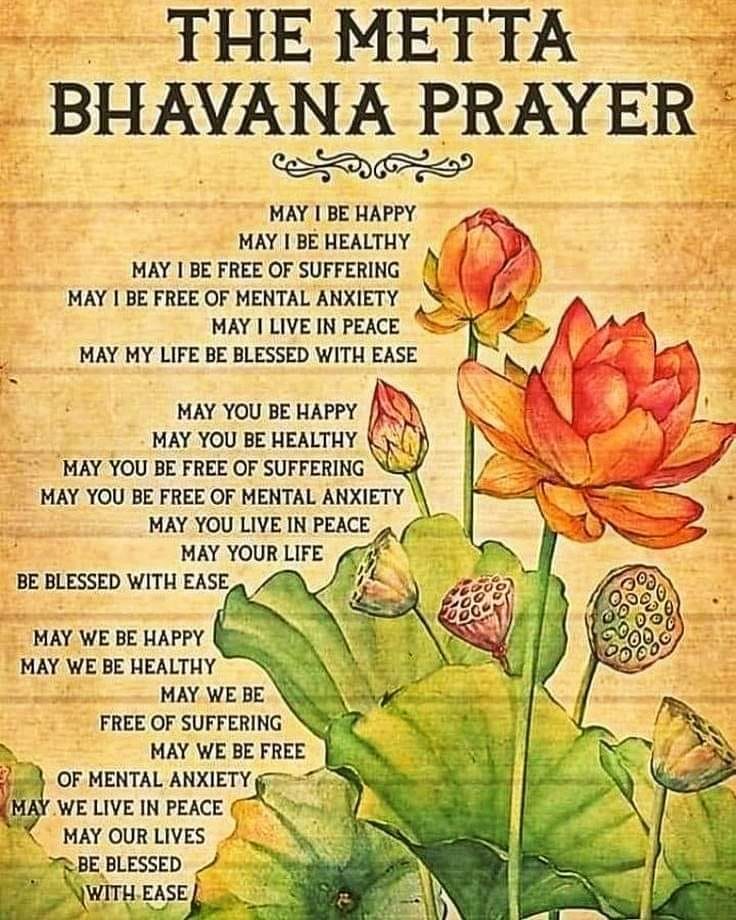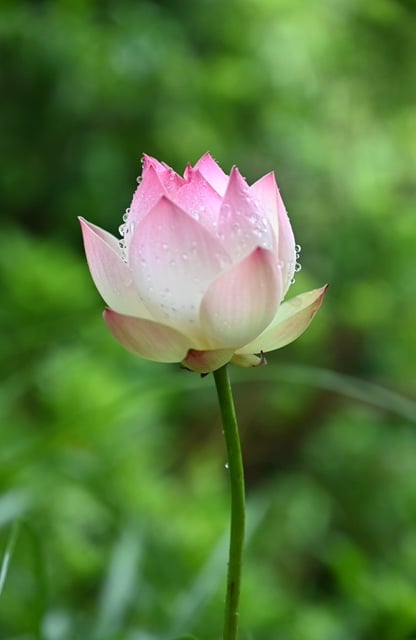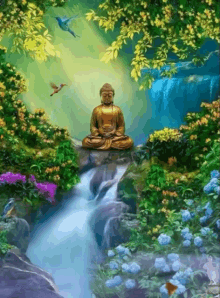Culture or Karma: Holy or Sin?
Culture (cultivation: from cultura) and civilization (urbanization, from civitas: city) are distinguished as spiritual and material. Spiritual cultivation aims at truth, goodness, beauty (cf. sciences, ethics, arts: intellect, volition, emotion), and holiness (religions, spirit: life).
Truth, goodness, and beauty may be limited in places and ages, thus need to be holy (wholly wholesome), though holiness in religions may be also limited by places and ages or by karma (action, habit, heredity). Thus, we must go beyond the limitations of space, time, and karma.
Gotama achieved nirvana (no-wind, of karma) and became awakened in the Dharma of Dependent Co-origination, i.e., all phenomena are dependently co-originated on causes and conditions, attaining freedom from and of karma for full function of and with all in space and time.
He showed that anyone can do the same in holy harmony, health, and happiness with limitless life, light, liberation, and love, beyond karmic samsara (full flow in birth, sickness, aging, death) and suffering (worry, want, weariness, hatred, loss, remorse, fear, divisiveness, doubt, delusion, etc.).
August 15, 2024 C.E.
Notes:
- German definitions of Kultur and Zivilisation as above are important because of their potential and limit. Culture is cultivating individual, inner (spiritual) potential, limitless in person, but limited in transmitting between persons (one must start afresh). Civilization is increasing social, outer (material) power (in commodity and convenience), and limitless in sharing among people in time and space (one can add up to previous achievement), but limited in materials and ecology (limit in resources and sinks creating individual, social, ecological problems).
2. Are there universal standards in truth, goodness, beauty, and holiness? It seems that life is the essential, fundamental standard of these values. Living beings find truth, goodness, beauty, and holiness in life affirming things. Even if it seems difficult to define beauty, living beings want to appreciate fresh clean air, water, bright sunrise and sunset, bright warm sunlight, beautiful flowers, tasty fruits, etc. Spirit is related with spirare: to breath, the vital, fundamental function of life, underlying the brain functions of intellection, emotion, and volition. Truth, goodness, beauty may be limited by areas and eras, so need to become holy to become more universal.
3. Karma is instilled with the triple poisons of desire, divisiveness, and delusion (of ego/mei: I/my). The Buddha said that all living beings are karma-birthed, -heirs, -owners, -machines, and -refuged. He clarified that there is no self-substance with self-sameness (permanent) and self-sovereignty (wishful) entities due to the Dharma (Truth/Law) of all dharmas (phenomena), Dependent Co-origination. We as karma-machines must change to the Dharma-refuged in order to change the world in suffering to that in holiness (wholly wholesome: harmonious, healthy, and happy).
4. Dharma means 1. form (from d-harm: phenomenon) and 2. norm (from d-h-arm: norm: law operating through phenomena: ethic), and 3. the teaching of the law of all phenomena, that is, Dependent Co-origination (originally awakened on the origination of perception/consciousness depending on the sense organs and objects, but later applied to all phenomena, cf. note 5). This law is similar to the law of causality, now used by sciences, but deeper and wider, applied beyond objects – more on subjects and symbols – ideas, etc.).
5. “The Dharma (Norm/Law/Truth/Ethic) of all dharmas (forms/phenomena/ truths/ethics)” is Dependent Co-origination, i.e., all phenomena are interdependently co-originated on limitless causes and conditions (similar to the Law of Causality, but deeper and wider – beyond conventions, conceptions, objects, etc.). This means that we are interrelated with other beings (other species, elements, stars, etc.), and relatives to each other, and that we must therefore live together harmoniously and strive to make a wholly wholesome world to become harmonious, health, and happy.
6. Sitting still makes one calm and clear, as a bowl settling down makes the water inside of it become calm and clear, reflecting the world. Constant cultivation of still sitting leads to calming (samatha/śamatha) and observation (vipassanā/vipaśyanā), nirvana and awakening (bodhi), witnessing the of truth world (Dhamma/Dharma-dhātu), and becoming the truth body (Dhamma/Dharma-kāya).
7. Religion derives from Latin religare (reunion). Religion is, thus, to reunite with holiness (wholly wholesomeness, cf. Rudolf Otto’s definition of religion as the Holy) from sin (=separation, separated sick, cf. a-sun-der, sundry). Religion can be defined as the way of life (manners, ceremonies, customs, traditions) and way to life (cultivation, completion, verification, achievement). Religions have been developing from particular to universal and from primitive to advanced, from mythical to rational, from pre-scientific to scientific – individual, tribal, racial, world, and universal.
8. To reunite with the holiness of the limitless ocean of life from being a separated small bubble or foam of ego or group ego is the goal of anyone or a universal religion, where one lives as a true friend in need of all, as expressed in Mitra, Mithra, Metteya, Maitreya, Mazda, Massiah, etc., and who lives in limitless life, light, liberation, and love.
9. A paradigm shift from our artificial, unilateral pyramidal civilization to a natural, cyclical Indra-net life culture for sharing life, heart, and harmony with the five blisses (awakening, freedom, equality, friendship, and peace) is essential to solve the global problematique. Culture is the cultivation of our potential in truth, goodness, beauty, and holiness (cf. sciences, philosophies, arts, and religions).
Please refer to the following for more detailed explanation:
文化か業か:聖か罪か?
文化(耕作:cultura に由来)と文明(都市化:civitas:都市に由来)は精神的と物質的に区別される。精神的耕作(修行:修養)は真善美(参考:科学、倫理、芸術:知意情)と聖(宗教:霊性:生命)を目的とする。
真善美は場所と時代に制限されるかも知れないので、聖(全体健全)である必要がある、宗教における聖も場所と時代、或いは業(行為・習慣・遺伝)に制限されるかも知らないが。だから私達は時・空・業のせい言を超越しなければならない。
ゴータマは涅槃(無風、業の)を達成して縁起、即ち一切の現象は原因と条件に依存して生起する、との法に目覚めて時空一切と共にその完全な機能の為に業から自由になりその自由を成就した。
彼は誰でもが業の輪廻(生老病死の完全な流れ)と苦(心配、渇望、倦怠、憎悪、消失、悔恨、恐怖、分断、疑惑、迷妄など)を超えて、無量寿・無量光・無量解(解放:自由)・無量愛と共に聖なる調和、健康、幸福の中に同様に出来る事を示した。
2024共通年8月15日
註:
1.上記のKultur と Zivilisationのドイツ語の定義はそれらの可能性と限界の故に重要である。文化は個人の内面(霊性)可能性、個人的には無限であるが、個人間の転移には限界がある(各個人は最初から始める必要がある)。文明は社会的、外的(物質的)力(商品と便宜)であり時空(を超えて、以前の達成に加上して)人々の間で無限に共有できるが、物質と生態では制限がある(資源と沈下には限界があり個人・社会・生態の問題を生ずる)。
2.真善美聖に普遍的基準があるのであろうか? これらの価値には生命が本質的、根本的基準がある様に見える。生物は生命肯定的な事柄に真善美聖を見出す。美を定義することは困難の様であるが、生物は新鮮で清浄な空気・水、明るい日昇・日没、明るく暖かい日光、美しい花、美味い果物などを好む。霊(spirit)は生命の生死に関わる根本的機能であり、知情意の脳機能の根底にあるspirare (呼吸する)と関係している。真善美は地域と時代に制限されるかも知れないので、更に普遍的である為に聖(全体健全)になる必要がある。
3.業は貪瞋(エゴ/メイ:我/我所の)痴の三毒が植え込まれている。ブッダ(覚者)は一切衆生は業—誕生者、—相続者、—所有者、—機械、—依拠者であると言った。彼は、諸法(現象)の法(真理/倫理)である縁起の故に自己同一(永住)と自己主宰(意欲通り)の実態をもった自己物質は存在しないことを明らかにした。業—機械である私達は、苦しむ世界を聖(全体健全:調和、健康、幸福)なる世界に変える為には、法₋依拠者にならなければならない。
4.法(dharma)は 形態(form: d-harmより: 現象:真理)、2.規則(norm: d-h-armより:現象中の規則:倫理)、3.諸法の法、縁起(元来は感覚器官と感覚対象に依る知覚・意識の発生に覚醒したが後に一切現象に適用されたもの。註5参照)。この法則は、現今諸科学に用いられる、因果律と同様であるが、もっと深く広い-客体を越えて主体と観念などの象徴に適用される。
5.諸法(形態・現象)の法(規則・法則・真理・倫理)は縁起(因縁生起)、即ち、一切現象は無量の直接原因と間接条件により相依生起するということである(因果則に似ているがさらに深く広い-世俗、観念、対象などを超える)。これは私達が他者(多種、要素、星宿など)と相依関係にあることを意味し、相互に相対的であり、私達が調和、健康、幸福になる為には共に調和して生き、全体健全な世界を作る努力をしなければならないことを意味する。
6.静坐は、椀が安住するとその中の水が静謐に透明になり世界を映すように、人を静謐に明澄にする。静坐の常時の修行は止(止静)(samatha/śamatha) と観(観法) (vipassanā/vipaśyanā), 涅槃と覚醒 (bodhi), に導き法界 (Dhamma/Dharma-dhātu:真理世界)を直証し,法身 (Dhamma/Dharma-kāya:真実身)になる。誰でも真実にある樹(両者共法:dharmaの語根 dhṝと同様永続を意味し一万年生き延びる樹もある)調和している樹(一切元素と調和し酸素、花、果、建築材など与える)の様に成れる。
7.Religion(宗教)はラテン語religare (再結合)に由来する。だから、宗教は罪(sin = 分離、分離病患, cf. a-sun-der, sundry)から聖(holiness = wholly wholesomeness 全体健全、参照 Rudolf Ottoの宗教の定義:the Holy)に再結合することである。宗教は生活の道(慣習、儀式、習慣、伝統)と生命への道(修行、完成、確証、達成)と定義る。諸宗教は特定から普遍へ、原始的から発展的へ、神秘的から合理的へ、前科学的から科学的へ‐個人的、部族的、民族的、世界敵、普遍的へと発展してきた。
8.エゴや集団エゴの分離狭小の泡沫あるいは泡群から無限の命の大洋に再結合することは誰もあるいは普遍宗教の目標である。そこでは無量寿、無量光、無量解放、無量愛を生きる友・友情(Mitra, Mithra, Metteya, Maitreya, Mazda, Massiah)で表される一切の必要の時の真の友として生きるのである。
9.私達の人工的で一方向の金字塔文明から命・心・和の分かち合いによる五福(覚醒、自由、平等、友情、平和)をもつ自然的で循環的な命帝網文化への枠組転換が地球問題群を解決する為には必須である。文化は私達の真善美聖(参考:諸科学、諸哲学、諸芸術、諸宗教)における潜在能力を修養することである。
詳細説明は下記を参照:
.
.
.
Metta: Friendship, Bhavana: Cultivation
.
.
.
.
,
,
,
,
.
.
.
.





